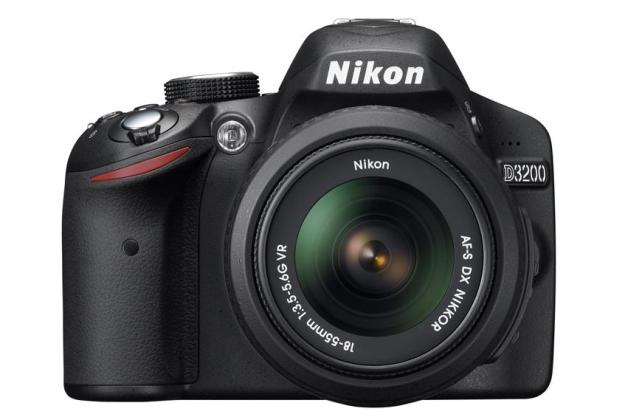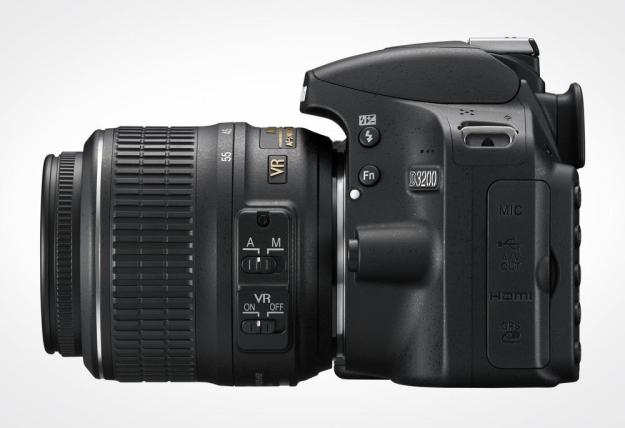
“Nikon is to be lauded for offering a 24.2-megapixel DSLR for less than 700 bucks. This is first and foremost a still camera, and as such does a very solid job.”
- 24-megapixel APS-C sensor
- High-quality stills
- 4 fps and full HD video at 30 fps
- Kit lens doesn’t do the sensor justice
- Noisy videos with high ISOs
The Nikon D3200 is a giant leap for consumer-friendly DSLRs. It has an amazing 24.2-megapixel sensor at quite an affordable price. Let’s see if Nikon lands on its feet after this jump — or falls flat on its megapixels.
Features and design
Not content with a small bump in resolution from the 14.2-megapixel D3100, Nikon leaped over archrival Canon’s 18-megapixel EOS Rebels — including the soon-to-be-released T4i. We still can’t get over the fact the D3200 has a 24.2-megapixel APS-C CMOS chip. The only other cameras with that size sensor are the mirrorless Sony NEX-7 ($1,199) and Translucent Mirror Technology Sony Alpha A65 and A77 ($849 and $1,349, respectively) DSLRs — and these prices are body-only configurations. On the surface, this looks like a screaming deal, but let’s dig a little deeper. Oh, in case you’re wondering, Nikon is using Sony chips, but its own processor and algorithms.

The basic design of Nikon DSLRs remains fairly constant, although the red Nikon swoosh is more streamlined on the D3200. Otherwise it and other dressed-in-black Nikon DSLRs look very similar. The controls have been re-jiggered a bit for the newer edition, with the red-dot movie button moving from back of the D3100 to a more convenient place next to the shutter button. Instead of flipping the Live View lever and then the red movie dot on the D3100, you press Live View and tap the red button near the shutter. Not a radical change, but different nonetheless.
The Nikon D3200 is available in black and red; we found the red case to be particularly unattractive, so fortunately our review sample was the classic black. The body has a plastic feel, and doesn’t have the heft of higher-priced enthusiast DSLRs. The front is dominated by the Nikon bayonet mount, and there are tons of EF-S lenses available. The kit is supplied with a classic 3x 18-55mm VR stabilized lens. You’ll also find an AF Assist lamp, a three-pinhole mic and a few tasteful logos.
On the top deck are the speaker, pop-up flash, hot shoe, large mode dial as well as movie, info and exposure compensation/aperture keys. An angled shutter button rests on the grip, which offers a nice handhold.
The knurled mode dial has all of the settings you’d expect on a DSLR — Auto, PASM, six common scene options, and so on. What lets you know right away this camera is for interchangeable lens camera newcomers is the Guide setting. Turn it on, and the camera will either make settings for the type of the photo you’d like to take, or give suggestions. It’s very helpful for those making the move from point-and-shoots. Say you want to take an image with flowing water: Just turn to “Show Water Flowing” and you’ll get directions for moving into shutter-priority mode and picking a slow speed. Pretty neat.

On the right side is a compartment for SD cards, while on the left are four ports for mini HDMI, USB, a mic and optional GPS. The bottom of the made-in-Thailand camera has the tripod mount and battery compartment. The entire body measures 5 x 3.8 x 3.1 (W x H x D, in inches) and is just fractionally larger than the D3100; both weigh the same: 16 ounces, body only.
What’s in the box
You’ll get the camera body, kit lens, battery, plug-in charger, strap, USB-A/V cables as well as various caps and covers. The battery is rated a very good 540 shots, per CIPA. The kit glass is the same old, same old from Nikon — an AF-S DX Nikkor 18-55mm F/3.5-5.6G VR lens. Given the 1.5x digital factor, this is basically a 27-82.5mm lens that’s not very bright (low f/stop rating) or with much reach. You should definitely budget for higher-quality glass if this is your first DSLR.
The camera kit also has a nicely-done 78-page user’s manual, and the full manual is on a separate CD-ROM, while ViewNX 2 software is on another. You’ll use this for managing and fixing photos as well as developing RAW files. For our tests, we used a 16GB SanDisk Extreme Pro SDHC UHS-I card with a 45Mbps rating. With media so cheap, we recommend you buy the fastest on the block, Class 6 or better.
Performance and use
We shot stills and videos over the course of several weeks, capturing scenes in New Jersey and Manhattan. When done we did our requisite pixel-peeping on the computer, made 8.5 x 11 prints with no post processing, and viewed videos on a 1080p plasma HDTV via HDMI.
The Nikon D3200 is relatively easy to use. We’ll say “relatively” because there are some not-so-obvious key controls for handling photo parameters. First the positives: If you’re buying your first DSLR, the D3200 is simple to operate as light switch. You turn it on, move the mode dial to Auto and the camera does all the work. If you’re a little unsure, just turn to the Guide setting and follow the instructions. It’s as simple as that — we’ll talk about the quality shortly.
For experienced photographers, the graphic LCD display, with its large circle symbolizing the aperture opening, is a bit annoying, and it takes up too much real estate. Fortunately, you can change this to a classic display by adjusting the set-up menu.

There are different types of adjustments available, depending on your mode. Even though there’s a scroll wheel on the back, you don’t use that for all changes. For ISO, for example, you have to press the info button, highlight the parameter you want to change, then use the up and down arrows on the controller. It’s not difficult, but dedicated ISO and white balance buttons would be appreciated. Then again, the D3200 is really for casual shutterbugs, not experienced camera reviewers. If you want these types of controls, aim higher, but be prepared to spend more.
The D3200 is a very responsive camera, given its massive megapixels. It starts quickly, grabs focus in no time thanks to an 11-point AF system (one cross type) and the AF Assist lamp. You can grab bursts of 4 fps at full JPEG resolution indefinitely in Manual or Shutter-Priority mode. This is all great on paper, but let’s get to the quality…
First off, you might ask yourself if you even need 24.2 megapixels. We can honestly say yes. Even if you don’t plan on making 20.1 x 13.3-inch prints with the 6016 x 4000 pixel files, the Nikon D3200 does a really fine job with color rendition. We shot most of our stills in JPEG Fine using Auto, and many other options on the mode dial. The Picture Control was set to Standard, but you can use Vivid if you want more pop. We really didn’t think it was necessary as we closely examined our images. Flowers had a nice richness, and it was fun closely examining hibiscus pistils at what seemed like microscopic levels as we increased magnification to 100 percent or more. This amount of detail is the real vote for more megapixels — you can easily crop a photo and still have plenty left over for a good-sized print.
Beyond flowers, beach scenes in bright sunshine were terrific, as were Asbury Park, NJ street art and architectural details. The same held true for mosaics on a classic NYC church. You’ll really like the stills captured by this camera. That said, it’s a shame the D3200 comes with a so-so lens. We recently tested the 24-megapixel Sony NEX-7 using an f/1.8 24mm Zeiss lens, and the combination of the sensor and glass was outstanding, but it was expensive. We strongly suggest a similar higher-quality Nikkor lens for the D3200.

Along with megapixels, ISO specs are reaching the moon. The D3200 hits 12,800, which is pretty high but far from the best. Naturally, more expensive DSLRs are in another galaxy — up to 204,800 for the Canon EOS-1D X with its $6,800 price tag; more realistically the $899 18MP Canon T4i also tops out at 12,800. Larger APS-C sensors — found in most DSLRs and many Compact System Cameras — do a much better job handling noise at elevated ISOs. In the case of the D3200, with noise-reduction engaged, we had no issues up until ISO 800. Beyond that, colors began to shift and noise became more pronounced. Still, at Hi1, which is 12,800, you could get away with a small print or a shot posted on the Web. Our tests also showed the built-in vibration reduction in the kit lens works well, allowing us to handhold the camera at slow shutter speeds.
The LCD screen is not the greatest, even with its high pixel rating. We definitely had issues in strong sunlight, having to duck into shadows to review our images at the default screen setting. If you’re heading outdoors, definitely ratchet it up to +3. This worked even at the beach on a very bright, sunny day. Nikon’s menu system is very straightforward and easy to follow. A walk through the full manual on the supplied disk would be a good idea, no matter your level of expertise.
A few other nitpicks. The Nikon D3200 lacks a good selection of art filters, a feature that almost all new cameras have in 2012. Also, there’s no HDR-type capture –merging three or four 24-megapixel frames on the fly is asking too much. The same holds true for the lack of exposure bracketing. These features will most likely appear on the refreshed D5100 when it arrives.
The Nikon D3200 captures full HD videos, 1920 x 1080 at 30 fps. This sounds great, but in reality DSLR video still lags way behind full-featured camcorders, with the exception of Sony’s Translucent Mirror Technology cameras, like the A57. We’ve said this many times: Contrast-phase detection (used by the vast majority of DSLRs) simply cannot focus as accurately as phase detection found on camcorders and Sony TMT cameras. There’s another critical issue as well — the sounds of focusing and vibration reduction mechanisms are picked up by the front mic on this camera and so many others. You can overcome this somewhat by foregoing using the zoom and manual focus… but then again, you can just record loud parties and not have to worry about it! Seriously, taking quality, in-focus movies is more work than it should be. That said, D3200 clips have reasonably accurate colors in good light but are particularly noisy with higher ISOs. On a more positive note, there’s little evidence of rolling shutter or “jelly” effects that plague other DSLRs and CSCs.
Conclusion
Nikon is to be lauded for offering a 24.2-megapixel DSLR for less than 700 bucks. This is first and foremost a still camera, and as such does a very solid job. It is clearly an entry-level model without the sophisticated tweaks enthusiasts crave such as bracketing, more cross-type sensors, HDR and even faster response. Yet for what you get, this one is easy to recommend — just be sure you’re well aware of its negatives.
Highs:
- 24-megapixel APS-C sensor
- High-quality stills
- 4 fps and full HD video at 30 fps
Lows:
- Kit lens doesn’t do the sensor justice
- Noisy videos with high ISOs
Editors' Recommendations
- Best camera deals: Save on DSLR, action cameras, point-and-shoot
- Nikon’s new 800mm lens for Z-mount cameras lightens the load
- Photography 101: Exposure, aperture, shutter speed, and ISO
- The best mirrorless cameras
- The best point-and-shoot cameras








